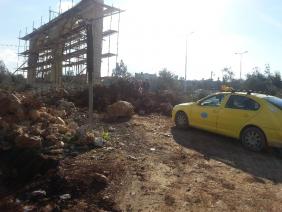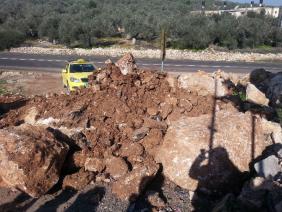A visit in solidarity with the village after its main road was blocked.
 The road leading to the village was blocked this week on Tuesday and our friends from “Engaged Dharma” invited us to a solidarity visit to the village, where they’re known as “friends of the village.”
The road leading to the village was blocked this week on Tuesday and our friends from “Engaged Dharma” invited us to a solidarity visit to the village, where they’re known as “friends of the village.”
We entered the village via Harith and wound through it toward the north entrance in the direction of the blocked road: Road No. 5066 which runs north of Funduk. A pile of earth and large boulders block the elaborate entrance now under construction. There we met representatives of the village.
A., who had been the head of the municipality until two months ago welcomed us along with Z., who accompanies him during the day. A. says this is the third this year the entrance to the village has been blocked because of stone throwing. This is collective punishment outlawed by the Geneva Convention. The road was recently blocked during  the olive harvest which made it extremely difficult to transport the crop. The blocked road connects Deir Istiya to Qalqilya and Tulkarm and villages in the area, and to the Emanuel settlement, and the barrier seriously disrupts travel. A 12 km. detour is necessary to reach the main road, wasting time and fuel. It reduces the income of laborers, harms students and the sick, and is humiliating. The residents tried twice in the past to dismantle the roadblock themselves. This time the army placed larger boulders which can’t be moved by hand.
the olive harvest which made it extremely difficult to transport the crop. The blocked road connects Deir Istiya to Qalqilya and Tulkarm and villages in the area, and to the Emanuel settlement, and the barrier seriously disrupts travel. A 12 km. detour is necessary to reach the main road, wasting time and fuel. It reduces the income of laborers, harms students and the sick, and is humiliating. The residents tried twice in the past to dismantle the roadblock themselves. This time the army placed larger boulders which can’t be moved by hand.
We asked A.: Have you a policy regarding stone-throwers? We believe that if people throw stones, they should be punished. They’re usually youths, aged 16-20. 25 village youths aged 14-21 have been jailed since the war in Gaza. People then wanted to show their support of Gaza. He doesn’t think stone throwing solves problems. “We’re against it.”
Do they talk to the youths about it? You can’t talk about, because then you’re on the wrong side. In meetings of the villagers we say it won’t solve problems. Are you protesting the roadblock? We believe it’s temporary. Perhaps for two weeks. That’s what happened before. We’re talking with the Red Cross, with human rights groups, etc. We don’t know who threw the stones. The army has cameras.
A. continued: It’s important to show what’s happening here. To inform the various groups. That’s what we think will help. He thanks us for coming to support them. The conversation took place next to a tall gate with two arches now under construction, blocked by earth and boulders. From there we went to a meeting at the municipal building.
A, who’d taken charge of Oxfam in the Salfit region (fair trade olive oil and tapenade), transferred the leadership of the village temporarily, until the selection of a new head, to a pleasant youth, age 32, with an MA in international relations. We were told Deir Istiya has the highest proportion of educated people (?).
Their plans: building a waste collection and recycling station to generate electric for the Salfit region, in Area B, to be completed by March, 2017. The village, with 4000 residents, has no problems with the supply of water from Mekorot. But the water from the Cana stream which runs through their lands is taken by Israel.
Z. takes us on a fascinating tour. It’s an ancient village. The old center stands on the ruins of an even older village from the Mamluke period. Z. led us to round roofs through rooms with domed ceilings and beautifully colored, decorated floors. We ascended and descended courtyards and alleys and peered through slits and mashrabiyyat and gates and moldings. One interior space led to another and another and another… The Shomron hills are visible from every lookout, and everything was green.
and moldings. One interior space led to another and another and another… The Shomron hills are visible from every lookout, and everything was green.
Wow, we though, the place has a huge potential for restoration and development as a Palestinian heritage site, a center for conferences, visitors, for… our imagination took flight… Has anyone ideas how to interest entrepreneurs and investors in developing this special location?
Most of the structures are deserted and some of them serve as a woman’s club, a duty clinic, youth club, a hostel during the olive harvest. The municipality laid sidewalks among the old buildings. Homes of villagers can be found between the old buildings. A family invites us for tea. The woman speaks Hebrew, works at the bindery in Emanuel. The husband is unemployed; he’s blacklisted from working in Israel and asks us to help him cancel it. Again Sylvia, from Machsom Watch, is the star.
From Deir Istiya we continued to ‘Azzun. We visited Z.’s family. He told us that Thursday night ‘Azzun had been closed off and also the lower road to Jayyous, and the entrance to ‘Izbet Tabib – after a Molotov cocktail had been thrown at a car with a father and daughter. 15 youths aged 16-19 were arrested that night. That evening we heard on the news that the suspects are from ‘Azzun. There were no soldiers or military vehicles at the entrance to ‘Azzun.
We returned via Nabi Ilyas and Umar’s plant nursery.
